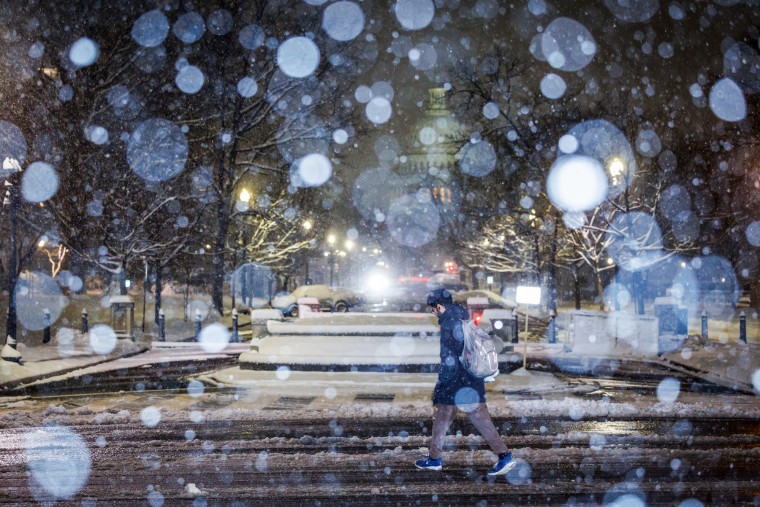The second of a pair of major winter storms socked the Midwest and the Plains on Wednesday, blanketing Chicago with snow, causing vehicle crashes and slide-offs in Nebraska and icing roads in Missouri.
The winter weather had 100 million people from Colorado to Maine under winter weather alerts and warnings early Wednesday, as one storm that hit the mid-Atlantic on Tuesday eased and the second struck the Midwest.
“I had a class to get to this morning, and it was just starting to come down. It wasn’t that bad,” Stephen Goodwin, 20, said in Chicago. “But then coming back from class — oh, man, it was a lot worse. It was kind of a shock, coming out of class.”
The Nebraska State Patrol responded to over 100 weather-related incidents on roads, including a crash between tractor-trailers that sent boxes spilling out onto the side of a highway, it said.
The first storm dropped a little more than 5 inches of snow on the U.S. Capitol on Tuesday into Wednesday, weather that prompted the Senate to delay the confirmation vote for Trump intelligence director pick Tulsi Gabbard until Wednesday morning.
The second caused snow and slippery conditions in Wisconsin, where multiple crashes caused a highway in the Milwaukee area to be closed for a time Wednesday, officials said.
By Wednesday afternoon, Pella, Iowa, recorded snowfall of 8 inches; Sharon Springs, Kansas, got 7 inches; and Freeport, Illinois, recorded 4.5 inches.
In the West, Los Angeles got rain, but heavier precipitation was forecast for Thursday. That prompted warnings from the Los Angeles County sheriff that evacuations could be ordered because of mudslides in areas that were burned by devastating wildfires in January.
The atmospheric river event could be California’s biggest winter storm of the season.

It's not just the snow. A cold snap is expected to last through the workweek in the northern United States and advance farther south.
The blast of Arctic air, which has meant parts of North Dakota reached minus 55 degrees Fahrenheit this week when the wind chill factor is added in, will move southward to the Ohio Valley and the central Appalachians by Friday, with temperatures 25 to 35 degrees below seasonal averages.
A huge area from near Seattle to the Twin Cites and south to Oklahoma was under a cold weather advisory Wednesday night, and more than 700,000 people in the Dakotas were under a more serious extreme cold warning, according to the National Weather Service.
In the South, where rain and flooding was the main concern, there were also two reports of tornadoes, one in Mississippi and one in Alabama, according to the National Weather Service. Trees were reported down and there was some damage to homes, but there were not deaths or injuries. Storm survey teams confirm whether reported storms were tornadoes after the fact.
Though the severe weather may be a nuisance for many, for others it was a winter treat.
At the Bronx Zoo in New York City, snow leopards and bears enjoyed frolicking in the flurries Tuesday. Students at Virginia Tech, where the campus was closed Tuesday, took advantage of the heavy snow to have a massive snowball fight. In the nation’s capital, a Georgetown Law student erected a snowman in front of the Washington Monument.
Burn scar debris fears in California
In California, 1 to 3 inches of rain will be possible across coastal areas, with 6 to 10 inches possible in the mountains and the foothills.
Gov. Gavin Newsom ordered a statewide response in advance of the storm — including the use of protective materials to contain burn scar debris from the Palisades and Eaton fires from entering creeks and rivers.
"The incoming storm could bring an increased risk of power outages, flooding in small streams and low-lying areas, and debris, rocks and mudslides on roadways," the state said in an update Tuesday night.
Concrete barriers known as K-rails, 319,00 sandbags and 5,600 so-called super sacks have been placed across Southern California to make protective walls stretching nearly 120 miles in total, and there has already been work to remove some debris in the last month, the state government said. More than 240 fire engines are already deployed, as well as 400 personnel in eight counties, five helicopters and 70 soldiers.
Los Angeles County Sheriff Robert Luna said at a news conference Wednesday that evacuation warnings are likely to be issued, possibly followed by evacuation orders, depending on the storm.
“Remember, if you’re ordered to leave, you may be gone for several days. I cannot stand up here and tell you will be gone for 12 hours, 24 hours,” he said. “We don’t know. It depends on the weather and the post-weather events that will impact your specific neighborhood.”
The state has also employed 14 geologists to study and map the burn scars to better understand possible debris flow.
The Pacific Northwest is not spared the winter onslaught. It will experience coastal rain and snow in the higher elevations Thursday as snow affects much of the Western states.

